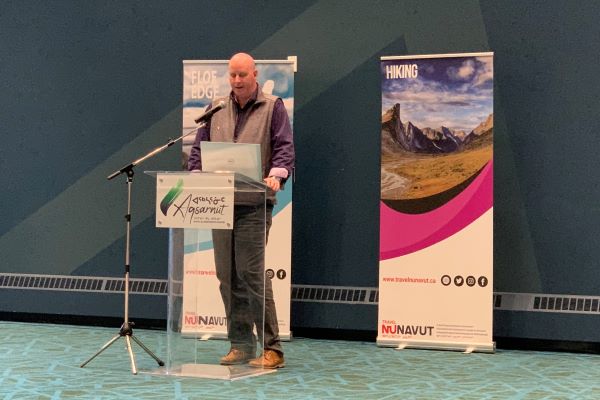

Finding practical, timely solutions to labour challenges was a key topic at the recent Travel Nunavut Conference & AGM. Dena Maxwell, Tourism HR Canada’s Director of Workforce Development, joined Clarence Synard, President, Baffin Regional Chamber of Commerce, and Shawn Lester, Owner, Lester Landau, to address HR Barriers for Tourism Businesses: How do we normalize hiring reflective of current realities?
Presenters and delegates discussed labour shortages, skills mismatches, employment barriers, and industry reputational damage. Tourism stakeholders shared thoughts around how best to tackle the misperception that the industry doesn’t have “real jobs”, training needs, and managing different generations.
Dena provided context on current workforce challenges and detailed actions Tourism HR Canada is taking to support Canada’s territories and provinces, including:
- The development of a pan-Canadian Indigenous Workforce Strategy. Working in partnership with the Indigenous Tourism Association of Canada, the aim is to develop a framework that can inform work both at a national level and a community level. Development will include tools to help attract, develop, and retain an Indigenous workforce. This project has just started, alongside development of a new workforce strategy for the broader tourism sector—but Dena emphasized the need to have unique features and an Indigenous-led approach for this important sector.
- The redevelopment of Discover Tourism. This attraction and retention program includes a website, a pan-Canadian career awareness campaign, a comprehensive set of tools, programs for high schools, a large series of video assets, and more. The program will support three user groups:
- Job seekers, workers, students—those looking at the industry for employment, whether a job or a career.
- Employers—providing them tools and supports to help better address their staffing needs.
- Intermediaries and influencers—educators, career development practitioners, community agencies that work with people wanting to enter the workforce, and parents.
- The Propel Student Work Placement Program, which supports tourism and hospitality employers in offering post-secondary students paid work-integrated learning opportunities. Propel creates a direct link between students looking to enhance their workplace skills and employers who can provide valuable experience, while also showcasing the depth and breadth of career pathways in the industry. Students gain paid hands-on learning and mentoring in their field of study. Employers acquire much-needed early talent to help with the recovery of the industry, as well as assistance with wages. Post-secondary institutions complement their programming by connecting students and the workplace.
- The Now Hiring Guide, a free resource to help employers attract and retain workers in a post-pandemic environment. The tools in this guide are intended to help tourism businesses get started on the path to recovery, with both short-term and long-term strategies to attract, retain, and grow a skilled workforce. Now Hiring covers a range of essential HR practices, tips to implement them, and practical checklists and forms to help tackle key issues.
Follow the development of these and other workforce initiatives: subscribe to Tourism HR Insider.
